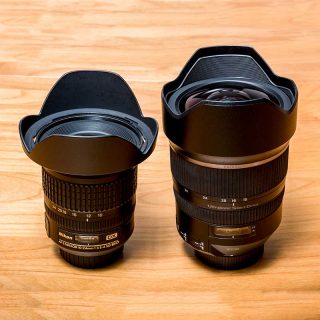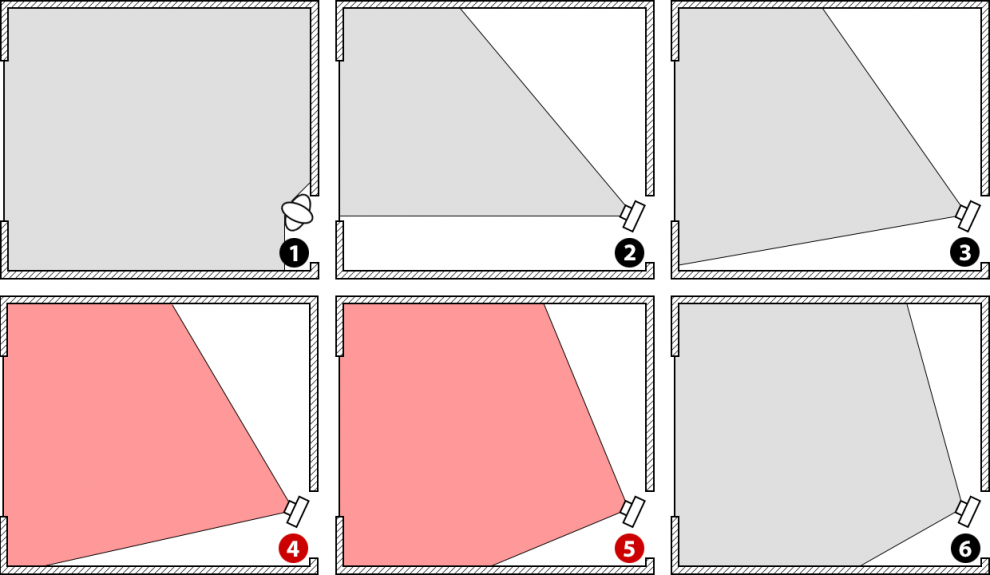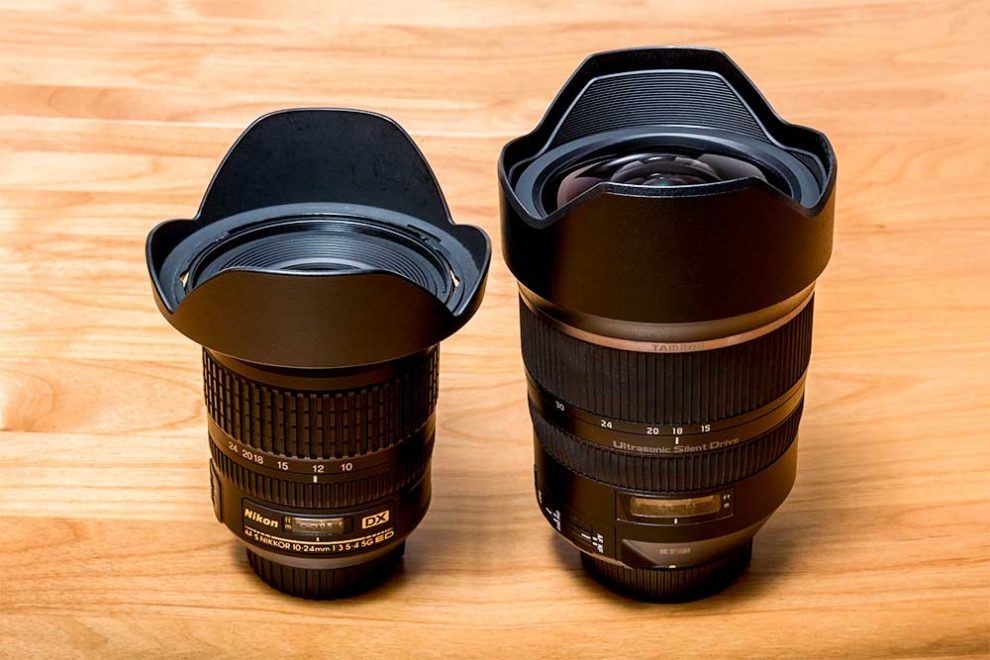
If you want to photograph an interior room format-filling, you often have to choose a large angle of view. This is provided by a wide-angle lens, recognizable by a small focal length value. However, such a strong wide-angle also has negative effects – photos give the illusion of larger space, images appear distorted and the image quality at the edges of the image may get poor.
- So how far can you go?
- Which focal length fits which camera?
- Which lenses are recommended?
In my workshops on real estate photography, these questions always come up when it comes to the appropriate equipment. So I wrote down some basic ideas. At the end of the article I also give recommendations for lenses with a suitable focal length and good quality.
Why Wide Angle?
When we enter a room of normal dimensions, for example a 4m x 3.5m rectangular room, our eyes can immediately grasp in the space in its entirety. This is because we have two organs of vision side by side, they are positioned slightly slanted to the sides of the skull, and the light-sensitive elements (pupils) are also mobile. This gives us a field of view of over 200°. In fractions of a second, our brain can calculate overlapping information from both eyes, compensate for distortions and thus save a „corrected“ image.
That is why the photographer chooses wide-angle lenses. Because they can display a large angle of view. However, the comparison to the human field of vision is bad: with an extreme wide-angle focal length, we only get a horizontal angle of around 125° in landscape format. In addition, the photos produced with it are full of image errors, that do not provide us with a realistic image of the space photographed: Distortions and vignetting as well as blurred image edges without straight edges become part of the photo.

A comparison of different horizontal angles of view (landscape format) in a standard room (4 x 3.5 m). Human and camera (full format) are each in position for the frequently used corner perspective.
1) human field of vision (incl. peripheral perception)
2) Normal focal length 50 mm – only a fraction of the space is imaged.
3) Lower standard zoom and common smartphone focal length 28 mm – The goal of showing at least three walls is not achieved.
4) Top superzoom focal length 24mm – informative shot possible
5) Lower superzoom focal length 18mm – informative shot possible
6) Ultrazoom focal length 14mm – possible to shoot, expect severe distortion.
For this reason, architecture and real estate photographers are always looking for the best compromise.
Focal Length and Crop Factor
Different focal lengths provide different viewing angles. Therefor a distinction is essentially made between three main categories:
- The so-called normal focal length is 50 mm. A standard lens of this kind delivers roughly the image scale that we perceive with one eye.
- A lens with a longer focal length is called a telephoto lens. It shows a smaller section of the image, enlarges the subject, objects appear closer.
- An optic with a shorter focal length is a wide-angle lens. It shows a larger section of the image, minimizes the subject, objects appear further away.
This information actually only refers to cameras with a large, so-called full-frame sensor. Its dimensions roughly correspond to the format of slides or negatives from analogue photographic times (24 x 36 mm). However, many modern cameras have sensors with smaller dimensions for reasons of cost and space. Different values apply to the focal length categories. If you still want to use the standard categories (wide-angle, normal, tele) as a guide, you can multiply the focal length value on the lens with a reduction factor and thus make a good comparison. This number is also referred to the crop factor.
- The factor for the DX sensors of cameras from the entry-level segment from Nikon and Sony is 1.5.
- For the APS-C sensors of the simpler Canon SLR cameras it is 1.6.
- The factor 2 is used for sensors in Micro Four Thirds cameras.
- For smartphones, it is around 10, depending on the model.
That is why the same focal length specifications on different camera types produce different angles of view. For easier understanding, the calculated values are rounded.
Overview of focal length categories considering the sensor size
There are now lenses that are calculated for the smaller sensor sizes (and still have optically correct focal length numbers for the full format). If these are used on cameras with a larger sensor, then only a small image circle is used. As a result, a black border (3) remains. On the other hand, lenses for large sensors can also be used on cameras with smaller sensors. Here only a part in the middle of the image will be projected into the camera (2).

Connection variants full format (FX) and DX / APS-C format
1. Image circle of the lens matching the camera sensor (FX+FX or DX+DX): The round image circle of the lens is optimally used by the rectangular camera sensor.
2. DX camera and FX lens: Only a section of the image circle of the lens is used by the smaller sensor. This causes a detail enlargement.
3. FX camera and DX lens: The small image circle of the DX lens cannot use the entire area of the large sensor. Shading at the image edges is possible.
Zoom or Prime?
Many professional photographers swear by the use of fixed focal lengths in so-called prime lenses. Although the focal length cannot be adjusted on the lens – it is fixed – such lenses often produce the best image quality. They have fewer moving elements and therefore make better use of the available space in the lens for controlling the light rays. However, you would need several suitable lenses for different scenarios (e.g. different room sizes).
That’s why there are zoom lenses with which the focal length, i.e. the angle of view on the lens, can be adjusted within a specified range. With these optics, the photographer is much more flexible, but accepts a slight loss of quality in the image. (Admittedly – these are often only visible to the photographer.) Since real estate professionals have to photograph many different scenarios and they like to travel light, a single, really good wide-angle zoom lens is essential for versatility. In addition, more lenses can be added later for special tasks (details, panoramas).
What focal length for real estate photos?
So if you want to photograph an average-sized room in a format-filling manner, the smallest focal length should have the following value:
- Full frame: between 18 and 24 mm
- DX / APS-C format: between 12 and 18 mm
- MFT format: between 9 and 12 mm

Ideal wide-angle lenses for real estate photos: left Nikon 10-24 mm, right Tamron 15-30 mm.
With this focal length range, for example, interiors can be produced according to all principles of photography (camera alignment, image composition, etc.) as well as in the technically acceptable range (edge curvature, color fringes, blurring at the edge of the image). The last-mentioned errors become smaller and smaller when choosing a larger focal length. Therefore, sometimes even a small increase in focal length is sufficient.
Tip 1: If you buy a lens with a slightly larger focal length range than mentioned above (e.g. 10 – 24 mm for DX), then you can easily eliminate the image errors at the maximum focal length by only shooting from 12 mm. For an absolute emergency, you still have a focal length of 2 more mm available as a reserve.
Tip 2: There are also so-called superzoom lenses, which cover a very large focal length range from wide-angle to telephoto. However, these have two disadvantages for real estate photos: 1. The lower limit in the wide-angle range usually does not reach the required angle of view. 2. Due to the many lens elements for the many focal lengths, the quality often suffers at the extreme settings required.
What about smartphones?
Smartphones usually have a focal length that is around 28 mm compared to the full format, depending on the model. Therefore, many models are hardly suitable for real estate photography.
Recommendations for good photo lenses for real estate photographye
First things first. When you buy a new camera, it’s best to buy it without standard optics. These so-called kit lenses are often of inferior quality. Better use the savings for a really good wide-angle zoom that suits your system. An old photographer’s saying goes: „A good lens is at least as expensive as the camera body.“ This is also based on the idea that you can often use a lens over several camera generations from the same manufacturer and the same camera class. For example, my first Nikon lens from 1991 also works on my professional DSLR camera and still produces first-class photos.
These are the recommendations, sorted by the zoom lenses most commonly used for real estate (excluding Sony). The links lead to detailed information on Amazon.de.
Full Frame (FX)
Nikon
i. e. for the following camera models:
D4, D5, D610, D750, D810, D850
Canon
i.e. for the following camera models:
1DXII, 5DIII, 5DIV, 5DS, 6DII
DX- / APS-C-Format
Nikon
i.e. for the following camera models:
D500, D3000- / D5000- / D7000 series
Canon
i.e. for the following camera models:
7DII, 70D, 80D, 100D, 200D, 700D, 750D, 760D, 1200D
Micro Four Thirds Format (MFT)
Olympus / Panasonic
i.e. for the following camera models:
GH4, GH5, E-M1, E-M10, E-M20
More gear recommendations
I post and update a number of gear recommendations on this site. You can find these on the following page:

